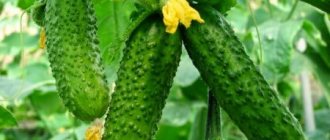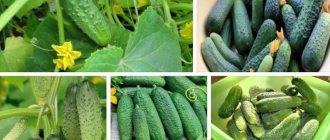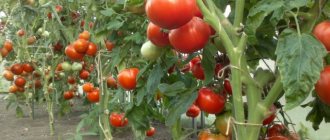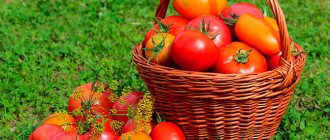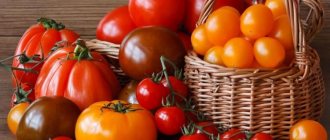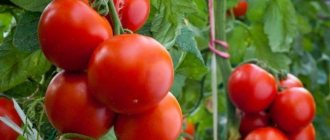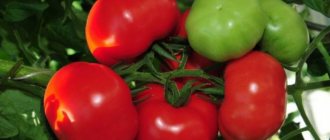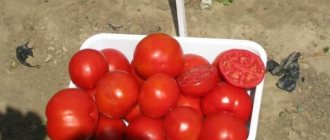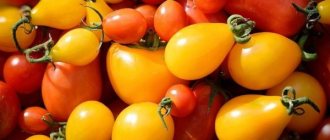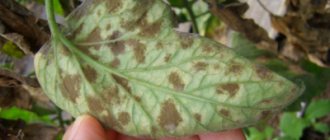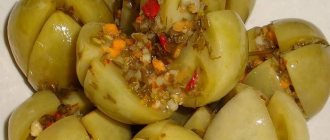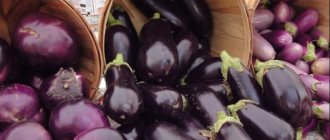Characteristics and description of the tomato variety Pickling delicacy
Pickling delicacy tomatoes are a determinate variety with an average fruit ripening period. This culture involves a seedling method of cultivation with further movement into the ground. The pickling delicacy is a standard form and has a straight, strong stem. The height of the bush is small, about 1 m.
Tomatoes Pickling delicacy are plum-shaped in shape, the fruits are medium in size. The color ranges from pinkish to pronounced red. The cluster contains up to 8 fruits. The weight of the pickling delicacy tomatoes is approximately 100 g. The seed chambers are evenly distributed inside the fruit, there are 4 of them. Tomato Pickling delicacy is well stored even in a ripe state and can withstand transportation over long distances.
Reviews and opinions of gardeners
Reviews confirm the specification of the variety. On thematic forums, gardeners share negative experiences of cultivating tomatoes in stationary greenhouses. Tatyana from the Kemerovo region had one. But in the open ground, the tomato pleased her with both yield and taste. The woman compares the variety with the French bunch. Tomatoes are indeed very similar in characteristics and appearance. Vera from Sverdlovsk region. I planted both varieties. The pickled delicacy turned out to be a little smaller.
Valentina from the same region called the variety similar to Siberian Surprise. There are minor differences in the height of the bush and the structure of the brushes. Nadezhda (Western Ukraine) highly appreciated the quality of the tomato. The summer resident used the crop for pickling.
Tomato is good for cool climates. Moreover, it is advisable to grow it in the open air or under a little protection. The commercial quality of tomatoes is excellent.
Pros and cons of the pickling delicacy tomato variety
Pickling tomatoes, a delicacy, as can be seen from reviews and photos, has a number of advantages:
- When the fruits ripen, they remain the same size;
- dense pulp and durable skin, which is ideal for preservation;
- pleasant taste, which allows you to use tomatoes not only for preparations, but also for consumption in salads and snacks;
- good keeping quality at home;
- preservation of presentation during transportation.
Important!
The tomato does not tolerate frost; when the temperature drops to 0 °C, the bushes stop developing, do not bear fruit and die. The advantages of the pickling delicacy make it popular among gardeners. In addition to their undeniable advantages, tomatoes also have some disadvantages. These include:
- poor resistance to late blight;
- with high humidity, fungus often appears;
- In dry years, productivity decreases significantly.
These disadvantages are easily compensated by the advantages of these tomatoes.
Advantages and disadvantages of the Moscow delicacy
Advantages of the variety:
- stable fruit ripening during a long growing season;
decent taste and nutritional characteristics;
stable immunity to viral infections typical of such crops;
greater productivity in small planting areas;
ease of care;
retains its presentation for a long time;
versatility in use.
Along with this, some shortcomings should be noted: the need to form a bush by tying it to trellises and poor resistance to late blight.
By observing the simplest agrotechnical standards, you can achieve a rich harvest. And vegetables in their original form, with a pleasant aroma and sugary taste, will delight you all winter.
Almost everyone who has planted the Moscow delicacy claims that this variety has many advantages in comparison with other varieties of tomatoes.
The main advantages of tomatoes include the following:
- long duration of fruiting;
- resistance to common tomato diseases;
- large and juicy fruits;
- ease of care when growing;
- the ability to collect 2–3 kg of ripe fruits from one bush.
Due to the above advantages, this variety is popular among vegetable growers. However, despite all the advantages, the Moscow delicacy has two disadvantages:
- rotting of ripened tomatoes due to waterlogged soil;
- the appearance of blossom end rot when bushes are close together.
Optimal growing conditions
In order for the yield of pickling delicacy tomatoes to be maximum, it is necessary to create the proper conditions for them. Lighting plays a key role in plant development. The Pickling Delicacy variety has some features that should be taken into account when cultivating it:
- The seeds are heated 2 months before sowing. This can be done on a regular radiator, the main thing is that the temperature is kept at + 27-30 ° C.
- When growing seedlings, the air should be heated to + 20-23 °C during the day and to + 12-15 °C at night. Young plants are gradually hardened by opening the window slightly.
- Planting seedlings in the ground usually coincides with the beginning of budding. During this period, the air temperature should be about + 20-25 °C during the day and not lower than + 16 °C at night. These are optimal conditions for fruit set.
- It is necessary to ensure such a watering regime in which the soil does not dry out, but excess moisture is also not formed.
The difference between tomatoes for pickling
The product for preservation is selected according to a number of criteria:
- small size, easily passing through the neck of the jar;
- thick skin, pulp;
- small seeds;
- sweetish taste appearing due to an increased concentration of carbohydrates;
- resistance to pathogenic microflora;
- ability for long-term storage.
When planting several varieties on a site, pickling varieties are placed separately, which will eliminate confusion during harvesting.
Growing
Growing tomatoes as a pickling delicacy is not difficult. The main thing is to follow the basic rules of agricultural technology. It is important to pay more attention to plants at the seedling stage.
Growing seedlings
Tomato Pickling delicacy is grown in seedlings both in open beds and in a greenhouse, depending on the climate in the region. Seeds are planted starting March 15th.
Soil for seedlings is made as follows:
- leaf turf in the amount of 2 parts;
- 1 part compost;
- wood ash - 1 part;
- 1 part sand.
When planting tomato seeds Pickling delicacy adhere to the following rules:
- the depth of the backlog should be within 1.5 cm;
- before germination, the boxes with seeds are covered with film;
- water for irrigation should be settled and at room temperature;
- the temperature is maintained at + 23 °C.
Picking is carried out when the tomatoes have formed 2-3 true leaves.
Advice! Experienced summer residents advise adding superphosphate and potassium sulfate in amounts of 30 g and 15 g, respectively, to 10 kg of soil.
Landing rules
Tomato seedlings are planted. Pickling delicacy is carried out when the night temperature is at least + 7 °C. For open ground, the planting date is approximately June 10, and for a greenhouse - mid-May. On a cloudy day, work is carried out in the morning, on a sunny day - in the evening. Plants are placed on the bed at the rate of 4-5 pcs. per 1 sq. m.
They form holes in the ground and pour water into them, wait for it to be absorbed, and pour it again. After this, seedlings are placed in them. Well-developed tomatoes with a strong stem are placed vertically, and elongated specimens are placed at an angle, leaving a top of 20-25 cm. After planting, more watering is required. It is recommended to form Pickling Delicacy tomato bushes into two stems.
Watering and fertilizing
The next watering is carried out 10 days after planting and then at the same interval. Use warm water, apply it directly under the root in moderate quantities. It is better to water in the evening.
Also, do not neglect regular weeding, because weeds interfere with the development of tomatoes. Mulching the soil will help retain moisture.
Pickling delicacy tomatoes need to be fed about 4 times during the season. Use mineral fertilizers or complex compounds. Fertilizing is carried out together with watering.
Pinching and tying
It is believed that the pickling delicacy tomato variety does not need pinching, but some gardeners advise removing shoots before the first bunch. It is better to tie the stems to stakes or low trellises.
Formation
There is no need to form a bush. Some summer residents still carry out this procedure, focusing on two stems.
Protection from diseases and pests
The pickling delicacy tomato variety has strong immunity to diseases common to this crop:
- Tobacco mosaic virus is a disease resistant to external influences that mainly affects seedlings. The pathogen is often transmitted through untreated garden tools. Its spread is facilitated by high humidity, dense plantings and poor ventilation. Yellow specks appear on the leaves, then they turn green, and the fruits become noticeably smaller.
- Brown spot - caused by a fungus, appears on the surface of the leaf with yellow spots, and underneath with a brown coating. At this stage, treatment measures are still effective. The leaves begin to fall and the plant gradually dies.
- Gray mold is a fungus that loves high humidity and coolness. Usually the disease is active in the fall at the first frost and the damage to the crop is small.
- Fusarium wilt - the fungus enters the plant in cold weather with high humidity and progresses in hot weather.
But at the moment the fruits ripen, Pickling Delicacy tomatoes are vulnerable to late blight. The disease manifests itself as brown spots on the leaves, then they spread to the stem. Treatment is effective only in the early stages.
To protect the plant from disease, the seeds are disinfected before planting. Seedlings are treated with preparations that contain copper. Bordeaux mixture or Hom will do.
The following pests are found on tomatoes:
- Aphids are tiny pests that attack the plant in entire colonies. The insect settles on the underside of young leaves and drinks juice from them. New ovaries do not appear and the bush gradually fades.
- Cutworm - caterpillars eat leaves, stems and the fruits themselves, causing damage to the crop. Over the summer and early autumn, several generations are replaced
- Slugs are mollusks that become active at high humidity and feed on the green mass of the plant.
There are modern means of protection against harmful insects - Decis, Actofit, Operkot. These drugs will help preserve the harvest without harming the plants.
Advantages of choosing seeds by planting region
To obtain high-quality fruits when harvesting, select seedlings according to the growing region. Plants bred for a dry climate with high air temperatures will not be able to actively grow and develop in the climatic conditions of the middle zone, even when planted in a greenhouse and following the watering and fertilizing regime. The volume of ovaries, the quality of the product will be reduced, the time to reach optimal maturity will be increased and the storage period will be reduced. Planting in a garden bed without additional covering is not safe. Low night temperatures will destroy the crop.
Recommendation! To obtain a full harvest, it is worth giving preference to zoned plant species that are adapted to specific climatic conditions.
Principle of seed selection
To obtain excellent tomato pickles, the seed material is chosen correctly:
- Size. The bushes should produce vegetables that have the same shape, weight and characteristic features. This will simplify the process of forming a jar for preservation. When planning a whole-fruit placement of vegetables, choose a product weighing no more than 100 g, for example, Lady fingers or Cherry.
- Maturation period. In addition to the period during which the tomatoes will be ready for harvest, the frequency of ripening is taken into account. For pickling, choose those varieties whose fruits will be ready for harvest at the same time. This simplifies the process of preparing for the winter.
- Level of resistance to mold and mildew. This will reduce the likelihood of vegetables spoiling before harvest.
To select a variety for pickling and canning, take into account the characteristic features.
Note!
The best fruit will be one that has a thin but strong skin, through which the marinade penetrates well and the pulp is saturated with its taste properties.
The advantage of choice remains with pickling material with a high concentration of carbohydrates - sugar. This preparation will be 100% successful in terms of taste.
